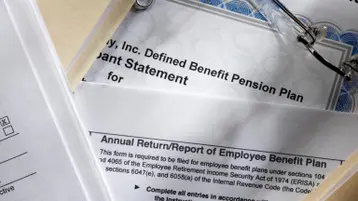Employee Retirement Income Security Act Marks 50 Years – Then, Now, What’s Ahead

Table of contents
- 1.Where did ERISA come from?
- 2.How has ERISA evolved over time?
- 3.Where does ERISA go from here?
This year on September 2, the Employee Retirement Income Security Act (ERISA) celebrated five decades since being signed into law in 1974. What does that mean for ERISA? At 50 years old, ERISA would be too young to enroll in Medicare. But if ERISA was a 401(k) plan participant, they would be able to make catch-up contributions, but wouldn’t be able to take a penalty free distribution from the plan unless some other distribution event applied. Of course, ERISA would want to check the plan document to determine whether they would be eligible for catch up contributions or a distribution, since the plan document always controls! Not too sure what ERISA is all about? Follow along as we break it down for you.
Where did ERISA come from?
Prior to 1974, employers often provided retirement benefits to employees through pensions, which are defined benefits. These defined benefit pensions generally promised that an employee would receive a specified monthly benefit payment throughout retirement, which would be funded by the employer. The amount of the benefit payment depended on several factors like the individual’s age at retirement, the number of hours the individual worked in a year, the number of years the individual worked, whether the individual was fully vested, and more.
During this time, the Internal Revenue Service (IRS) was the primary regulator of these defined benefit pension plans. The U.S. Department of Labor (DOL) later got involved through the Welfare and Pension Plans Disclosure Act (WPPDA). The WPPDA required some filings and annual financial reports, but not nearly as extensive as what is required under ERISA now.
However, in 1963, the closure of a car manufacturer, Studebaker-Packer Corporation, was one of the main catalysts for ERISA’s inception. Studebaker had promised generous defined benefit pensions to its employees, but its pension plan was underfunded, and it could not provide these promised benefits. The existing regulatory scheme did not provide sufficient remedies for the impacted employees. The Studebaker closure, along with other controversies regarding unpaid pension benefits, lead to President John F. Kennedy commissioning a study on pension plans in 1963. Ten years later, on Labor Day, September 2, 1974, President Gerald Ford signed ERISA into law, thereby setting minimum standards for defined benefit pension plans and helping to ensure that employees and former employees could rely on the pension promises their employers made.
It is important to ensure employers pay promised benefits, because when employees make career choices, retirement benefits could be a major factor for them, perhaps forgoing higher wages during employment for the promise of pension benefits in retirement. Even though pensions are not as common now, (replaced by 401(k) and other retirement funds) they still exist in the public sector and in unionized workforces. Workers continue to factor in benefits when making employment decisions, and benefits such as retirement options can serve to not only recruit but retain talent.
How has ERISA evolved over time?
Over time, ERISA was further amended to not only regulate pensions, but all types of employer-sponsored retirement plans and health and welfare plans. These updates include a number of other acronyms you may be familiar with like the Consolidated Omnibus Budget Reconciliation Act of 1985 (COBRA), Health Insurance Portability and Accountability Act of 1996 (HIPAA), Genetic Information Nondiscrimination Act (GINA), Children's Health Insurance Program Reauthorization Act (CHIPRA), and recently, the 2010 passage of the Patient Protection and Affordable Care Act (ACA). In addition to the DOL, which includes the Employee Benefits Security Administration (EBSA), the Department of Health and Human Services (HHS), the Pension Benefit Guaranty Corporation (PBGC), and the IRS, all oversee the administration and enforcement of ERISA—and add even more acronyms to the mix!
ERISA, among other things, established duties for plan fiduciaries to act solely in the interest of participants and beneficiaries. This concept was borrowed from trust laws. ERISA also requires plan disclosures to participants and annual reporting to the government (some of which includes funding information for certain type of plans), so that participants and beneficiaries, as well as the government, have adequate information regarding their plans. ERISA also includes other provisions establishing parameters for the benefit of employees like prohibiting employers from establishing plans with cumbersome eligibility or vesting requirements. And of course, it also gives a number of agencies authority to audit plans, enforce ERISA provisions, and assess civil and criminal penalties for ERISA violations.
Where does ERISA go from here?
ERISA has been amended many times, often to make retirement plan benefits for employees more secure. Most recently, the Setting Every Community Up for Retirement Enhancement (SECURE) Act and SECURE 2.0 continued this trend with provisions that attempt to make saving for retirement more inclusive. For example, SECURE 2.0 includes a provision that permits employers to match student loan repayments. Prior to SECURE 2.0, generally employers could only match based on an employee’s contributions to the plan. Thus, if an employee didn’t have enough in their paychecks to contribute to their employer’s plan, they would not be able to take advantage of employer match. This provision was added to make it easier for younger members of the workforce, who may tend to have more moderate incomes and higher levels of student loan debt, to save towards retirement in a tax favored manner and benefit from employer matching provisions. Take a deeper dive into SECURE 2.0 in another TriNet blog here. Looking forward, there are already talks about what provisions SECURE 3.0 might include to help workers save more and earlier for retirement.
On the health care side, ERISA also continues to evolve so that public policy goals align with health plan requirements. For example, health plans are subject to the Mental Health Parity and Addiction Equity Act (MHPAEA) and any related rules and regulations seek to treat mental health and substance abuse disorders the same way that a physical health benefit like broken collar bone is treated. Mental health is more broadly considered an important aspect of health generally, which certainly was not the case when ERISA was first enacted. Before the MHPAEA, group health plans could place more restrictions on accessing mental health and substance abuse treatment. Before covering these types of services, health plans could require prior authorization or limit annual visits, even if those limits did not apply to other physical health benefits. Because of the MHPAEA, health plans can only place the same limits on mental health and substance abuse disorders that exist for physical health benefits. The MHPAEA provides further access to mental health services, recognizing their importance to health care, and likely helps to destigmatize these services by increasing accessibility. As such, it would seem that health care, in part through ERISA, will continue to progress based on the consensus of what constitutes health care.
Need more help navigating ERISA? TriNet can help. Contact our experts today to see which HR solutions are best for your business, including learning more about accessing big company benefits and TriNet’s 401(k) retirement plan. This can help you attract top talent, give your company a competitive advantage and help boost employee retirement savings.
© 2024 TriNet Group, Inc. All rights reserved. This communication is for informational purposes only, is not legal, tax or accounting advice, and is not an offer to sell, buy or procure insurance. TriNet is the single-employer sponsor of all its benefit plans, which does not include voluntary benefits that are not ERISA-covered group health insurance plans and enrollment is voluntary. Official plan documents always control and TriNet reserves the right to amend the benefit plans or change the offerings and deadlines.
This post may contain hyperlinks to websites operated by parties other than TriNet. Such hyperlinks are provided for reference only. TriNet does not control such web sites and is not responsible for their content. Inclusion of such hyperlinks on TriNet.com does not necessarily imply any endorsement of the material on such websites or association with their operators.

Melissa Shimizu
Table of contents
- 1.Where did ERISA come from?
- 2.How has ERISA evolved over time?
- 3.Where does ERISA go from here?





